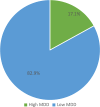Optimizing minimum dietary diversity: examining appropriate complementary feeding practices and influencing factors among children aged 6-23 months in Ghana; a cross-sectional study
- PMID: 39934732
- PMCID: PMC11817239
- DOI: 10.1186/s12889-025-21681-z
Optimizing minimum dietary diversity: examining appropriate complementary feeding practices and influencing factors among children aged 6-23 months in Ghana; a cross-sectional study
Abstract
Background: Inappropriate supplementary feeding techniques put children under the age of two in danger of malnutrition, illness, and death. However, only a few children receive nutritionally appropriate and diversified diets. It is noteworthy that achieving minimum dietary diversity plays a pivotal role in the attainment of Sustainable Development Goals. However, the double burden of malnutrition poses a significant threat to achieving these goals.
Methods: A health facility-based cross-sectional study was conducted from April to July 2021. A multi-stage sampling technique was used to sample 422 study participants. Data were collected with a paper-based questionnaire, coded and entered into Epi-Data version 3.1. Data extraction was carried out in Excel Sheet for cleaning and then later exported into STATA for analysis. The dependent variable explored in the study was MDD. The independent variables considered in our estimation include; mothers' age (years), educational level, marital status, ethnicity, occupational status, religion, place of residence, sex of the child, age of the child (in months), and complementary feeding practices.
Results: Out of the 422 participants, the majority of them 343 (81.0%) had good dietary practices. The prevalence of MDD among the children was 17.1%. On the other hand, educational level [aOR = 3.16 (95% CI: 0.75-13.29), p = 0.001] and ethnicity [aOR = 24.72 (1.43-15.64), p = 0.011] were statistically associated with children's high MDD.
Conclusion: The study concludes that while MDD was low among the children studied, breastfeeding was common but gaps existed in providing essential food groups, with significant influences from maternal education and ethnicity. The study highlights the need for targeted interventions to enhance dietary practices for children aged 6-23 months. Specifically, the study emphasized scaling up comprehensive public awareness campaigns to raise awareness about the importance of dietary diversity for child health and development.
Keywords: Children; Factors; Feeding practices; Ghana; Minimum dietary diversity.
© 2025. The Author(s).
Conflict of interest statement
Declarations. Ethics approval and consent to participate: All methods were in accordance with the Declaration of Helsinki. The University of Health and Allied Sciences Research Ethics Committee (UHAS-REC) reviewed the study and approved it with a reference [ID:UHAS-REC A.12 [112] 20–21]. Permission was also obtained from the Hohoe Municipal Health Directorate before the commencement of the study. During data collection, permission was also sought from all the in-charges of the facilities where data was collected. The study did not directly involve the children therefore, written informed consent was obtained from all mothers before the administration of the questionnaire. Competing interests: The authors declare no competing interests.
Figures
References
-
- UNICEF. The first 1,000 days of life: The brain’s window of opportunity [Internet]. 2013 [cited 2023 Aug 2]. Available from: https://www.unicef-irc.org/article/958-the-first-1000-days-of-life-the-b...
-
- WHO/UNICEF. Indicators for assessing infant and young child feeding practices. World Health Organ. 2021;WHA55 A55:122.
MeSH terms
LinkOut - more resources
Full Text Sources
Medical
Miscellaneous



